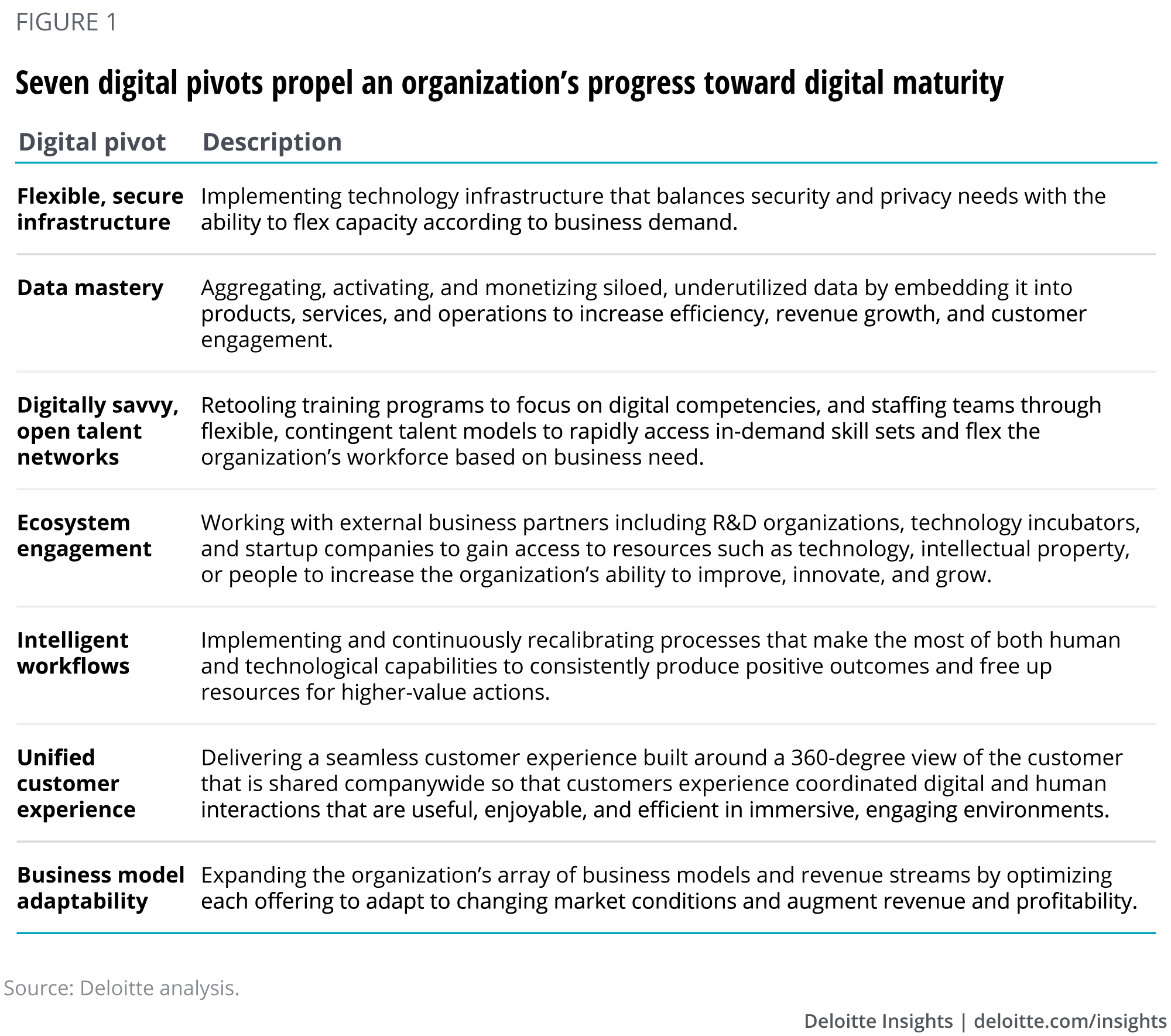
3 Foundational Pivots
While all “pivots” are important, some come first. Yes, plumbing, heating, insulation are all important when building a house, but let’s get the concrete foundation right first. These are foundational: 1) flexible, secure infrastructure 2) data mastery 3) bringing talent along for the journey.
1) Invest early in flexible, secure infrastructure
Deloitte has identified 63 (yes, slightly odd number) pivot applications which can transform a specific function. I’m speculating that “specific function” means something like accounts payables, strategic sourcing, or transactional pricing. Also, I am speculating that if you want Deloitte to tell you 1) what those applications are 2) how they help you gain a step-function advantage 3) where you rate on 1-10 scale – you should give them a call, and pay.
Here’s how they describe a flexible, secure infrastructure.
This entails adopting cloud infrastructure; embracing agile/DevOps methodologies; developing and using technology platforms where possible, rather than ad hoc applications; and implementing a cybersecurity strategy, among other elements. – Deloitte, 2019
2) Data mastery is a path to insight
“Mastery” is a big word because it makes me think of Jiro Dreams of Sushi-level of zen amazingness. However, passing on that level of impossible mastery, Deloitte does describe this as a pervasive capability to make smart, real-time decisions. Deloitte often talks about innovation at the “edges” of the organization, which I appreciate. It’s one thing is 3-4 people in the corporate headquarters have a clear line of sight, but what about the retail cashiers, sales people, manufacturing shift managers? Are these micro-decisions being made thoughtfully?
3) Bringing the talent along the journey
This wording is a little interesting as there’s a connotation that the organization understands the journey with some precision, clarity. Journey, yes. Talent yes. Bring along, probably not. Imagine this is a lot of discovery for the organization AND the talent. This is probably what Deloitte was thinking, intending, because see how they talk about “networks” here:
Accordingly, the digitally savvy, open talent networks pivot is an amalgam of practices intended to give organizations access to the right talent at the right time. These include retooling training programs to focus on digital competencies and staffing teams through more flexible, contingent talent models to rapidly access in-demand skill sets and flex the organization’s workforce based on business need. – Deloitte
Love these sets of words because they capture the open-ended, creative nature of this investment in human capital:
- Right talent, right time
- Digital competencies
- Flexible, contingent talent models
- In-demand skill sets
Focus on one function and go deep
Crux: Once you have the digital foundation in place, #1-3, you need to make a choice. Pick a function – finance, procurement, sales – and digitally transform it completely. In other words, don’t spread digital peanut butter across the company. No. Pick one thing and do it right. BOOM.
This approach helps organizations build confidence in their ability to execute the pivots. And it allows leaders of other functional areas to observe the benefits of transformation achieved by those who have gone first. This can build organizational momentum to support the scale and scope of change that digital transformation requires. – Deloitte
4) Engaging with the ecosystem can accelerate innovation
This is definitely a harder one. Create an (external) ecosystem that feeds, creates, vets, and launches innovation. This includes supplies, universities, startup, industry groups, and outside-the-company complementers. No question, this makes most executives uncomfortable.
5) Intelligent workflows can unlock new opportunities
This is DMAIC. Continuous improvement and recalibration.
6) Excellent customer experience is a hallmark of digital maturity
Deloitte describes this as a design thinking-type of exercise to imagine what the unified customer experience looks like. Think backwards from the customer. My LEAN friends might agree with the idea, but ask a deeper question of why this is step #6. Shouldn’t this be step #1. . .Namely, shouldn’t all this talk of digital transformation tackle the main questions of what the customers value now (and in the future), and what is helping us get that done. Zero-based budget folks would also ask what’s need to keep the customer happy, and isn’t the rest – uh – less useful?
7) Business model adaptability helps capitalize on new opportunities
This makes sense, and is also a huge leadership question. Once you changed the organization’s digital ability, are you courageous enough to make the step / leap to the next S-curve? Getting stronger, more flexible, and agile is great. Now, as a leader, what are you going to do?
Is this a chicken & egg question? See the survey results below. Many say the current operating model is the challenge to digital transformation. Or is it the other way around? All grey-hair practitioners know that change requires head, heart, and hands. You don’t have to count up to the McKinsey 7S model to know that strategy, skills, systems, structure all matter.
Digital Transformation = $2 trillion in 2022, 16%+ CAGR
It’s difficult to calculate precisely, because there is some non-MECE between digital transformation spending and baseline IT investment, but Market researcher IDC projets that digital transformation spending globally will reach nearly US$2 trillion in 2022, with a 16%+ CAGR.
Find the original article from Deloitte here (12pg).
Related posts:
